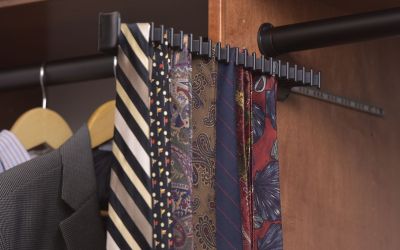The Importance of Proper Closet Ventilation

When was the last time you thought about how air moves inside your closet? It’s easy to focus on organizing or cramming in that last pair of shoes, but ventilation? That probably doesn’t cross your mind often. However, good airflow in your closet matters more than it seems. Here’s why proper closet ventilation is important.
Prevents Mold and Mildew Growth
Closets are compact, enclosed spaces, which makes them a hot spot for moisture buildup. Clothes, especially garments with natural fibers like cotton or wool, release moisture into the air over time. Add in damp shoes or gym bags, and you’ve created the perfect recipe for excess humidity. This issue only worsens in areas with high humidity levels or during rainy seasons (when moisture lingers in the air longer).
Once moisture starts building up, mold and mildew can thrive. These fungi settle on surfaces like wood or drywall and latch onto your belongings. Your favorite leather boots could suddenly smell musty, or your cherished jacket could develop unsightly spots. Beyond damage, mold spores can trigger health problems, from sneezing and coughing to more severe respiratory issues.
However, you dry out the moisture that feeds these fungi by allowing air to circulate through vents, louvered closet doors, or small fans. Additionally, you could add moisture absorbers to the closet corners for extra protection during wetter months.
Here are specific ventilation solutions for different closet styles:
- Built-in reach-in closets: Add a vent or a small louvered section to improve airflow.
- Walk-in closets: Use a combination of an exhaust fan and natural ventilation by periodically keeping the door open.
- Freestanding wardrobes: Place moisture absorbers or strategically position fans to enhance air circulation.
Preserves the Longevity of Clothes, Shoes, and Accessories
Closets trap heat and stagnate the air. When this happens, your closet becomes an environment where delicate fabrics like silk, linen, leather, suede, and cashmere break down faster. Moisture can lead to discoloration, cracking, or an unpleasant musty smell, especially in leather.
Proper closet ventilation is important because it preserves the longevity of clothes, shoes, and accessories. Essentially, well-circulated air combats the moisture and heat that causes fabric and material degradation. Switching out a solid closet door for a louvered one allows for constant airflow. If replacing doors isn’t an option, keep the door open or cracked when possible.
Clothes packed too tightly together block air circulation, so spacing out your items also helps. Use cedar blocks or activated charcoal bags in shoe racks and accessory shelves to absorb moisture and odors. These techniques keep your favorite clothes looking and smelling fresher for longer.

Minimizes Unpleasant Odors
Closets can become unintentional odor traps due to their enclosed nature. Damp shoes, sweat-soaked gym wear, or even plastic storage containers can all contribute to unwanted smells. These odors mix and linger in the still air, creating a less-than-pleasant aroma every time you open the door.
Since closets are small, these smells can intensify over time and spread to clothing or other items. The smells can settle deep into fabrics, leaving coats, scarves, or linens stale despite being clean. Luckily, good airflow stops odors before they become permanent. Circulation helps replace trapped stale air with fresh air, eliminating the need for frequent deep cleaning.
Avoids Structural Damage to the Closet
Humidity doesn’t just affect your belongings; it slowly wears down the closet itself. Excess moisture in a wood closet system can warp wooden shelves, soften painted surfaces, and result in moldy patches on drywall. Over time, this damage can cause structural integrity issues, leading to costly repairs. Houses in humid climates or homes with older closets face this problem more frequently, especially if builders didn’t include ventilation.
Installing air vents or grilles at the top or bottom of your closet doors allows air to circulate naturally, keeping moisture levels stable. For rooms prone to high humidity, digital humidity monitors and portable dehumidifiers can help.
If you can’t make structural changes, silica gel packs are an excellent, low-maintenance way to absorb excess moisture in specific spots. Place them near baseboards, on shelves, or beside shoe racks to combat problem areas directly. Another option is using moisture absorbers, such as calcium chloride containers, which are especially effective during wetter seasons.
Improves Overall Indoor Air Quality
Closets with limited airflow can affect the air quality in your entire home. Dust, allergens, and mold spores build up in sealed spaces and eventually spread when you open the door. If you have a closet near your bedroom or living room, that stale air moves into spaces where you spend the most time. Trapped humidity can aggravate respiratory issues or allergies. You may notice more sneezing, coughing, or general discomfort.
You can find small ways to maintain fresh air in your closet between larger ventilation updates. Regularly cleaning shelves and corners reduces accumulated dust and allergens that otherwise circulate. Using a HEPA-grade air purifier near closet-heavy areas keeps the surrounding air crisp. Even small and simple changes, like keeping your door slightly ajar for part of the day, allow airflow to handle pollutants before they migrate.

Maintains Proper Temperature Control
Closed doors and cramped layouts seal warmth in, especially if the closet shares a wall with a bathroom or kitchen. Over time, these increasing temperatures make closets feel stuffy, impacting the space and your home’s overall comfort.
Excess closet heat damages sensitive materials and household products. For example, perfumes and skincare stored in these conditions may degrade faster, while clothes with wool or silk may fade or wrinkle faster. Even electronics or batteries tucked away in a warm space can malfunction.
Fortunately, proper ventilation regulates the air inside the closet, keeping the temperature consistent with the rest of your home. Swapping out solid doors for ventilated ones lets heat escape naturally. Installing a closet-specific fan or using a portable dehumidifier maintains balanced temperatures. These tools work quietly but have noticeable benefits for your belongings.

